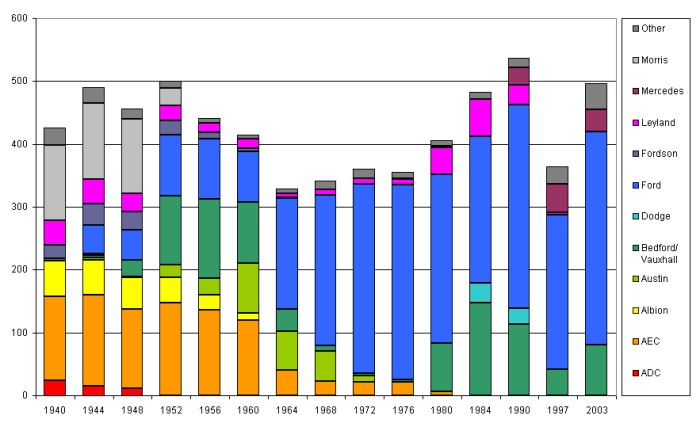 .com - London Transport Service Vehicles on the web
.com - London Transport Service Vehicles on the webAn all-new version of this website is now available at www.ltsv.com/sv/. These pages are no longer being updated.
 .com - London Transport Service Vehicles on the web .com - London Transport Service Vehicles on the web | |||||||
An all-new version of this website is now available at www.ltsv.com/sv/. These pages are no longer being updated. | |||||||
| Fleet Statistics |
| Fleet Composition 1940-2003 |
 |
| This chart is derived from data contained in the SUP-15 publication by LOTS and, for later years, the Bus Handbook series and lists on this site. As such, some of the figures are based on observations and may not be completely accurate, and the length of the time periods is not consistent. They do serve to illustrate the major trends however. Most apparent is the rise of Ford. The first (then badged as Ford Thames) were tippers bought during the war, and reasonable numbers of small vans followed. The arrival of the Trader, D-series, Transit and Escort models saw Ford become the preferred supplier, achieving almost complete fleet domination by the mid-1970s. Since then there has been a return to multi-sourcing, but large numbers of Transit vans mean Ford is still the main supplier of service vehicles today. AEC was the traditional builder of London buses, and they also supplied a good number of lorries. The chart above shows a very gradual decline in numbers with the last being withdrawn in 1984. Albion shows a similar pattern but disappears considerably earlier. Other manufacturers didn't last as long. Phases of using Morris (1940s), Bedford (1950s) and Austin (1960s) are all apparent, as is the brief resurgence of Leyland and Dodge in the 1980s. Today's fleet is therefore mainly Ford, with Bedford (now Vauxhall) as an alternate, and Mercedes preferred for larger vehicles. The overall fleet size shows considerable fluctuation around an average of about 400. The large drop between 1990 and 1997 is due to the privatisation of the bus fleets, while increased maintenance requirements on the underground and the increase in the use of leased vehicles potentially account for the general fleet expansion since the 1970s. |